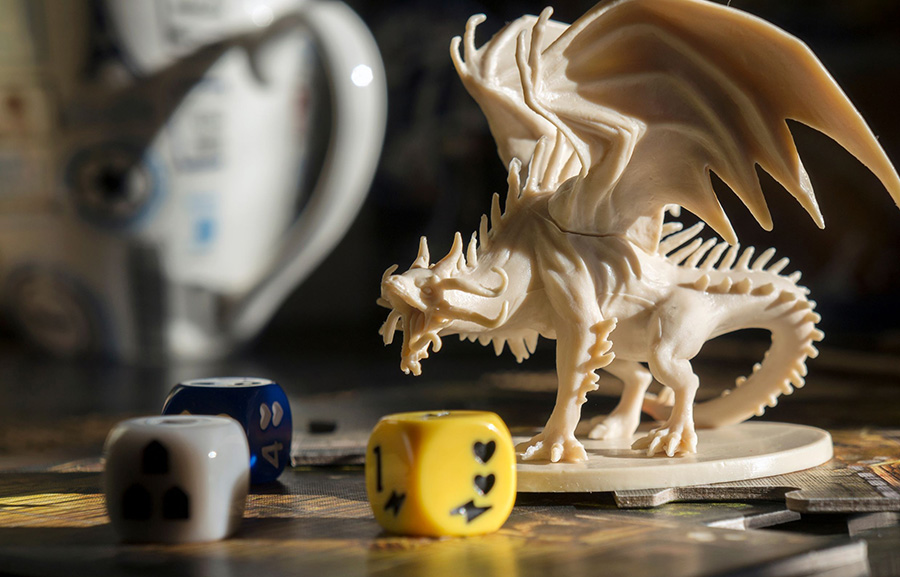If you’re reading this, chances are you’re hoping to learn more about a fantasy role-playing board game called Dungeons and Dragons. If you’re after a simple beginner’s guide to the dice in the game then look no further. First introduced in 1974, this game involves embarking on quests and leveling up game experience. What others often enjoy about this game is the story that’s being told as they play the game while being creative and having control over the narrative. It’s up to you what you’ll do, how your characters will look, and what will happen next, and altogether, this creates one unique and exciting experience.
As a quick overview, the basic setup of the game first starts with appointing a Dungeon Master (DM). The DM will serve as your gameplay’s referee and narrator. Next, you’ll choose your characters and their general skills and place these in your character sheet. In the character sheet, names, experience points, abilities, levels, and equipment will also be listed.
Dungeons And Dragons Dice
Another critical aspect to understand about the game is how rolling the dice works, as this can play a significant role in whether you’ll succeed in the game. For instance, a die called the D20 will determine whether a skill, outside combat, will prevail. Dungeons and Dragons primarily has six dice: the D20, D12, D10, D8, D6, and D4. Moreover, the higher you roll in the game, the more likely you will succeed.
The dice are indeed an essential part of the game, and if you’re interested in having more designed dice, consider checking Adventurer’s Loot out. To learn more about how the dice in the game work, consider reading the following guide:
Purpose Of Each Die
Before discussing when it’s strategically advantageous to roll your dice, you may want to learn about the function of each die. This will be promptly and further elaborated below:
D20 (Icosahedron)
Known as the most crucial die of the game, the D20 determines if you’ll succeed in any attempts you make at combat, ability check, skill check, and saving a throw. With this die having 20 sides, the chance of rolling any side is 5%.
D12 (Dodecahedron)
With 12 sides, this die is used when trying to deal damage with a large weapon carried by a raging barbarian.
D10 (Pentagonal Trapezohedron)
These ten-sided dice come in pairs included in the D&D 7-dice set. Unlike the other dice with faces starting from 1, this is numbered from 0 to 9. Moreover, it’s used to make a percentile roll. You roll them together and combine their results. However, it’s worth noting that a 0-0 roll won’t result in 0% but 100%.
D8 (Octahedron)
This eight-sided die is used for damage done by larger weapons.
D6 (Cube)
The most well-known die, which you may have already used in other board games, the cube die or D6 has six sides, and it’s used for character creation. You’ll roll it four times, discounting the lowest number, while the rest are numbers assigned to attributes depending on where the player assigns them.
D4 (Tetrahedron)
Also known as the caltrop, this die offers low variation. Furthermore, it determines the damage made by smaller weapons and healing spells.

To Roll Or Not To Roll
With the purpose of each die used in Dungeons and Dragons established, the next step would be to understand when it would be strategically sound or required to roll.
To Roll
Rolling For Ability Checks
This essentially determines if you’ve succeeded in a given task using your ability. You’ll also include your ability modifier and proficiency bonus in this role if you have these.
Rolling For Attack
This is done when you want to attack an opponent during combat. If you’re using a melee weapon, you can include your strength modifier or use dexterity if you’re using a ranged weapon.
Moreover, you’ll add your proficiency bonus if you have this. It’s worth noting that certain spells may use a spellcasting ability modifier, and if you roll a 20 on the D20, it’s considered a critical hit.
Rolling For Damage
To determine precisely how much damage you’ve dealt the enemy, you’ll have to do a damage roll. The weapon or spell you use will indicate the kind and number of dice to roll, along with the damage you will do.
Saving Throws
Lastly, the saving throws serve as a way to avoid or reduce the effect of a harmful move. The source of offense will indicate what kind of ability score ought to be used, along with what happens if you succeed or fail.
Rolling Again
In this unique situation, the DM may allow players to roll again if they fail the first time. However, it’s encouraged that you try other ways to solve the problem.
Not To Roll
Lacking Ability Score
When you lack the proficiency to perform a particular task, you can’t roll for an ability check, as you still have to learn or attain the ability. For instance, lockpicking would require proficiency in Thieves’ Tools. If you don’t have this proficiency, the DM will forbid you from rolling to attempt.
Avoiding Combat
Another reason why you might not roll is when you can and want to avoid combat. You won’t have to roll initiative and face the opponent.
Conclusion
Dungeons and Dragons can be a daunting game to play, as there are many aspects to understand—from setting up the characters and dice to navigating the overall gameplay. However, having a thorough understanding of this game—including how the dice work and when to roll them—will help you craft a solid strategy as a Dungeons and Dragons player.
With the guide above, hopefully, you now have a better understanding of when to roll the Dungeons and Dragons dice. Consider learning more about the other aspects of the game to create a better and winning strategy.

